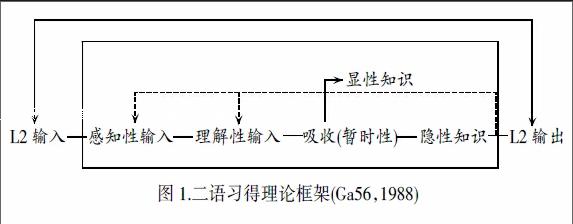初中英语语言材料的有效性输入设计初探
2017-07-27陈惠燕
陈惠燕

摘要:语言的输入是输出的前提,初中英語教学可以从语言材料的有效性输入着手,设置真实的语境,结合模块话题,巧妙设计教学,做到语言材料的输入有效、高效,进而提高初中英语教学的实效性。本文从课文教学中语言材料的输入入手,结合教学实例阐述了基于话题模块的语言材料的有效性输入。
关键词:初中英语;语境;有效性输入
中图分类号:G632.0 文献标识码:A 文章编号:1992-7711(2017)06-0032
一、问题的提出
初中英语的教学过程包含英语语言材料的输入和输出两个过程。语言材料的输入与输出在语言学习和交际中相辅相成、相互促进。Krashen(1985)的输入理论认为:输入是语言习得的根本途径[1]。Ellis(1994)里提到Gass所提出的理论框架,该框架对二语习得的过程做了一个概括性的说明,如下图所示:
可见,语言的习得过程是“输入——吸收——输出”的过程,输入是输出的必要前提。
语言材料的输入除了有利于培养学生的语感,提高学生对语言运用的灵敏度和准确性,还具有帮助学生积累一些有用的语言素材的作用。然而许多初中英语教师在组织课堂教学的过程中,只重视对语言知识的传授,忽视了学生对语言的感受性学习和对有用语言素材的积累。由于教师对教学中语言材料输入不够重视,导致了诸如学生记不住单词,英语语言表达能力较低等教学问题。笔者认为教师可以从设置真实的语境,结合模块话题着手,巧妙设计教学,提高初中英语教学语言输入的实效性。
二、基于话题模块的有效性输入设计
1. 明确语言目标
首先,教师在设计语言输入活动前必须明确语言输入的目标。以人教版初中英语七年级下册Unit5 Im watching TV为例,教师需明确本单元的功能目标是用现在进行时谈论人们正在做什么,话题是日常活动。要让学生谈论日常活动,教师需先向学生输入相关日常活动的词汇,如:Studying: be doing (ones) homework , be reading (a book) ; Entertainment: be watching TV , be playing computer games ; Sports: be playing soccer ; be swimming 等。除此之外,教师还需让学生熟悉相关的句型,如,What are you doing ? , Im watching TV .Whats he/she doing? He/She is doing homework.等。
笔者认为,只有教师本身清楚要向学生输入什么,才能根据目标去设计输入活动,也只有这样设计出来的输入活动才是有效的。
2. 设置真实语境
初中英语的教学缺乏自然习得英语的环境,而语言又需发生在一定的情境中。所以,教师在设计语言输入活动时,应该设置真实的语言输入环境,使学生身临其境,让学生感知具体的形象,进行感受性的学习。仍然以人教版初中英语七年级下册Unit5 Im watching TV为例,本单元涉及到新的语法结构——现在进行时,笔者在向学生输入相关句型时,会设置如下教学步骤:
(The teacher holds a basketball in his hand )
T : Whats this?
S1: Its a basketball.
T : Can you play basketball? (Maybe some students cannot answer the question, teacher may give them smile and encouragement.)
S2: Yes, I can.
(Give the basketball to the student)
T : So, please play basketball for us? (Students may be shy, teacher should try to give them courage . When the student is playing basketball, the teacher asks)
T : Whats he doing? (Give students 2 seconds to think over , students may not answer the question, since its a new sentence. Then teacher give the answer)
T : He is playing basketball. (Pay attention to the pronunciation of“is doing”and “is playing basketball”)
Using other things that prepared by the teacher to practice the sentences again and again.
在这个教学过程中,笔者所设计的输入活动使学生在一定的真实语境中去感受现在进行时的基本句型,利于学生的感受性学习。
3. 优化双边活动
通过之前真实语境的设置,学生对词汇和句型有了基本的感性认识,在接下来的教学过程中,教师可以通过听力和阅读的训练对学生进行反复的刺激,不断加深他们对语言材料的印象。笔者仍以人教版初中英语七年级下册Unit5 Im watching TV为例,谈谈听和读两个输入环节中双边活动的优化设计问题。
(1)听力的设计
运用听的技能来辨别和理解话语。听的训练可以结合特定语境练习。以人教版初中英语七年级下册Unit5 Im watching TV (2a-2b)的听力教学为例,笔者从听前、听中、听后入手,设计了如下教学步骤:
① Pre-listening.
Before listening, ask students to look at the two questions in activity 2a.
Q1: What is Steve doing?
Q2: Does Steve want to go to the movies?
T: The conversation is talking about what Steve is doing. And from question 1, we know you may give the answer like “...” (Try to help students to give the pattern)
S1: We may answer the question 1 like “ He is + Ving”
T: Clever boy. And what about question 2. We know that there will be two kinds of answers, right?
S2: Yes.
T: And what are they?
S3: They are “Yes, he does.” and “No, he doesnt”
在聽前,教师引导学生预设答案,并告诉学生听力的主题,帮助学生提前构建听力框架,对听力的理解起到一定的作用。
② While-listening.
Activity 1
Play the tape for the first time and ask students to listen only.
Play the tape for the second time and ask students to answer the two questions of activity 2a.
Give students 2 minutes to discuss their answers in pair.
Ask two students to write their answers on the blackboard.
Activity 2
Show the following paragraph, play the tape again and ask students to listen and fill in the blanks.
Jack: Hello, Steve.
Steve: Hi, Jack.
Jack: What (1) you (2) , Steve?
Steve: Im (3) TV.
Jack: Do you want to go to the (4) ?
Steve: That (5) good. This TV show is boring.
Students may not fill in all the blanks for the first time, so teacher may play the tape again.
Walk around the class and give them help if necessary.
Encourage some students to write their answers on the blackboard.
在听中,教师适时的对课本材料做了整合,活动一的设置让学生带着问题听,这样学生听的时候就有针对性,有的放矢听。同时在核对答案环节,采用了小组活动的形式进行讨论,培养学生的合作精神。活动二的设置,让学生听力填空,利于学生通篇理解听力材料,捕捉关键词。
③Post-listening
Play the tape and ask students to repeat the conversation above. Teacher can play the tape sentence by sentence and ask the students to repeat one by one.
听后的跟读可以让学生进一步熟悉听力材料,培养学生的语感。
(2)阅读的设计
运用阅读的技能来辨认文字符号,理解文字的意义。阅读训练除了可以是针对课文的有声阅读训练,包括边听课文录音、边看文字、边理解词句意义等,还可以运用选择、填充、补充、判断和推理等形式对材料进行处理。
现仍以人教版初中英语七年级下册Unit5 Im watching TV (3a)的阅读教学为例,笔者从读前,读中,读后入手,设计了如下教学步骤:
①Pre-reading
T: Before reading the passage, please look at the four pictures in activity 3a. The boy in the first picture is Mike. And what is he doing?
S1: He is playing basketball.
T: Quite good. Youre a clever boy. Now look at picture 2, who is the girl? What is she doing? And what about picture 3 and picture 4. Try to guess.
Divide students into four groups and give them three minutes to discuss with their partners.
Walk around the class and remind students to guess the answer in case they should read the text to find the answer.
T: OK. Times up. Now what are your answers?
Try to encourage several groups to show their opinions.
T: Wow,your answers are all excellent. Now lets begin to read the text and find out who is correct.
閱读前,教师引导学生观察课文的插图,做出适当的预测,通过阅读前的预测,学生巩固了本单元的现在进行时的句型:He is + Ving ; She is + Ving . 有助于学生对文章的初步理解,让学生带着疑问进行进一步的阅读,激发他们的求知欲,为读中任务的完成做铺垫。
②While-reading
Activity 1: Skimming.
T: Now boys and girls, you have five minutes to read the text, and after reading, try to get the main idea of it.
A. Its a letter about Mikes four pictures.
B. Its a letter about Lindas four pictures.
C. Its a letter about Ginas four pictures.
这个教学活动意在培养学生快速阅读的能力。教师设置较为简单的问题,学生通过快速阅读得以完成,于此同时,略读又可以训练学生快速获取文章主要信息的能力,利于提高学生的阅读速度。
Activity 2: Careful Reading.
T: Now you have 10minutes to read the passage and try to choose the correct answers of these questions. OK, begin.
1. The letter is from
A. Linda. B. Mike. C. Gina.
2. Where is Mike playing basketball?
A. At school. B. At home. C. At the pool
3. Who is Linda?
A. She is Mikes sister.
B. She is Mikes pen pal.
C. She is Ginas pen pal.
4. Whats Gina doing?
A. She is playing basketball.
B. She is swimming.
C. She is doing her homework.
Ask several students to show their answers.
T: Now read the letter again and number the pictures in the right order.
Walk around and give the help if necessary.
T: So after reading the letter, you have the answers to the questions before reading that you have guessed, right?
细读是读者通过仔细阅读文章细节,接受、记忆、分析阅读材料的阅读方法。学生通过细读,从文章找到某一特定的信息,从而更进一步理解文章。
③ Post-reading
Read the passage and ask students to repeat.
Give students 5minutes to read the letter by themselves.(Give help if necessary)
Encourage several to read it out.
在读后的任务设计中,先让学生跟读然后朗读。笔者在设计一些情节较为生动的阅读材料时,经常让学生分角色朗读文章,培养学生在朗读中发掘文章深度的能力。
三、反思与体会
通过上述分析和论述,教师在设计有效的输入活动时应该做到明确语言目标、设置真实语境、优化双边活动。除此之外,笔者认为,教师在设计听和读有效性活动时还应注意以下几点:
首先,是教师在对学生进行听力训练时,不仅要将听力原文和答案教给学生,更要教会学生听力技巧,授之以渔,教学生如何理解听力内容。
其次,是教师要有意识地增加学生的文化背景知识,提高学生对阅读和听力材料的文化背景的预设能力。
再者,是指导学生进行课外的泛听,由于课时有限,教师应该指导学生选择合适的听力材料,提高学生听力技能。帮助学生选择难度适中的课外阅读材料,使其有一定的量的积累。
最后,是在设置Post-reading 任务时,模仿性的写作是很好的任务设计。如人教版初中英语七年级下册Unit5 Im watching TV (3a)的阅读教学中,笔者会在读后任务中让学生完成3b的写作任务。
总之,语言的输入是输出的必要前提。初中英语教学过程中语言输入活动的设计,要围绕英语课程标准的要求,设置一定的真实语境,结合不同的听的训练和读的训练,由易到难,由机械到灵活,帮助学生积累丰富的语言材料,培养他们听的技能和读的技能,从而促进其说和写能力的提高。
参考文献:
[1] Krashen S. The Input Hypothesis : Issues and Implications[M].NY:Longman. 1985.
[2] Rod Ellis. The Study of Second Language Acquisition[M] .Oxford University Press. 1994.
[3] 全玉梅,林雪玲,何闽娥,杨延从,杨鹏辉. 厦门市初中新课程英语学科教学指导意见(试行).2010
[4] 教育部.英语课程标准(实验稿)[S].北京:北京师范大学出版社,2001.
[5] 廖传风.语境与语境教学法[J].外语界,2000(4).
[6] 胡壮麟,朱永生,张德录.系统功能语法概论[M].长沙:湖南教育出版社,1987.
(作者单位:福建省厦门市巷西中学 361000)
